D Jensen
-
- LNG Design: Necessity is the Mother of all Invention Marine News, Mar 2014 #46
Jensen Maritime Consultants – leveraging a unique porthole on the maritime industry – anticipates and meets demand in the burgeoning maritime LNG sectors. Nevertheless, says Jensen’s Johan Sperling, it’s not rocket science.
At the recent Passenger Vessel Association (PVA) annual meeting held in Houston, Texas, Jensen Maritime Consultants had on display just a couple of their many design efforts underway at the Crowley-owned design and engineering shop. Naturally, those designs had the use or carriage of LNG as their central theme. LNG, at least on this side of the pond, is still largely uncharted waters, but that’s hardly the case for Jensen. Already at the heart of many new initiatives, it is clear that Jensen will never be far from the LNG epicenter when it finally takes off here in North America.
Early Engagement – Unique Perspective
Although owned by Crowley, Jensen’s client base is wide and includes all sizes and types of tonnage. That said; Jensen Maritime Vice President Johan Sperling says that his firm has a unique view on the industry that, perhaps, some competitors do not. That window potentially provides a sharper look at what could come next. Nevertheless, he says, business is business. “We have NDAs with all of our clients. We have a half dozen, each with somewhat different designs, including Crowley. I’m sure you can imagine that everyone wants to be first, but at the same time do not want to tip off the competitors to what they are doing. At Jensen – and a lot of people don’t realize this – 80 percent of our business is not Crowley-related. So we have strict firewalls in place and we’re very good at keeping promises to others about what we are doing.”
Ongoing in-house projects include the LNG bunker barge, the LNG-powered tug, LNG powered ATB designs and of course, the design work with the larger, faster and environmentally-friendly liquefied natural gas (LNG)-powered, combination container – Roll-On/Roll-Off (ConRo) ships. Already in the thick of LNG, Jensen will provide construction management and supervision in the shipyard throughout the building phase of the ConRo’s.
In terms of Jensen’s LNG tug design, the preliminary work was, to a certain extent, a leap of faith on the part of Jensen. Sperling says, “We have contracts for clients, but we started before we had those contracts and went out on a limb ourselves and decided to design something that would attract those clients.”
The LNG bunker barge was a different story because the maritime industry needs infrastructure to move LNG. Sperling explains, “Harvey Gulf, Tote, Crowley, and Matson have decided to spend a lot of money to build large vessels that will burn LNG and gas. They have to get the gas to the vessels. Meanwhile, there are very few groups are willing to take the risk to help with the ‘chicken and egg’ question.”
Sperling and Jensen nevertheless remain pragmatic. “First of all, it’s not rocket science. We’re not overly worried about the technology itself and I don’t think that anyone else is, either. LNG has been around a long time. Vessels don’t burn LNG, they burn gas. And when it changes to gas, it expands, which can present a problem. You basically take LNG and vaporize it, then it’s virtually the same system as compressed natural gas for over-the-road buses, dump trucks, etc. The safety record is very, very good. But, that said, if you spill LNG, all kinds of things can happen. LNG is cryogenic fluid, is extremely cold and causes myriad of considerations. So we design to meet those challenges. From our standpoint these are the most challenging areas. The good news is that this has been done for a long time and it has been long documented and we have in-house LNG experience here at Jensen.”
Defining the Ideal Bunker Barge
Jensen’s bunker barge designs are a closely guarded secret, but Sperling said that Jensen would focus on two basic sizes – ranging from capacities of 2000 to 3000 cubic meters. He added, “If you look at all the carriers that are contemplating or have committed to building LNG tonnage, all of the schedules are different. Some want to top off weekly, for example. Our designs satisfy most of the demands of what a big ship operator could want. The bunker barge has to be large enough to where it makes sense, but also small enough that it is affordable and economical. Others may be building bigger, some smaller. We’ve defined our range.”
Sticker Shock
According to Sperling, the first bunker barge has to be built as economically as is possible. That’s because the first mover in the market will have a limited customer base, at least to start with. He insists, “If it’s too expensive, you’ll have to charge too much for bunkers,” adding, “Once you talk about LNG equipment, the sticker shock is tremendous. In our case, we’re looking at simple cryogenic tanks – cylindrical in construction typically – that is proven technology. That’s the easiest way to get regulatory approvals. And, even though it is new for marine applications, you can point somewhere and say that it works. We’ll incorporate this into our bunker barge designs.”
Jensen’s philosophy is that there is enough risk in these new ventures without introducing unknown variables. Sperling told MarineNews in February, “The Rule of thumb today: LNG equipment is about double the price of non-LNG components. We’re talking about the equipment. Whoever moves first takes the most risk because they are going to spend a lot of money and then the prices are going to drop. You don’t want to be first and get it wrong. This has certainly changed but the exponential cost jump is still there for LNG equipment.”
Risk – and Reward
In the beginning, Jensen went forward with its LNG pioneering efforts for several reasons. Sperling says, “It was a big risk – for a naval architect, time is money and we spent a lot of R&D time on this. In this case, we felt the risk was low enough because we think it’s real enough that someone will eventually pay for it and that’s exactly what has happened.”
Jensen’s LNG design for tugboats got started in 2008. Since then, a lot of water has gone under the proverbial bridge. Sperling adds, “The engine manufacturers are just now ready to do something. And, as you can see, the first LNG tug has just been delivered out of a shipyard in Turkey for service in Norway oil fields. As you’ve probably seen in all those drawings – the LNG tanks were right underneath the house and accommodations. In the U.S. today, for safety reasons, we are designing vessels that put the LNG tanks somewhere else that is not in the same vertical zone as the accommodations. We have some constraints here that make it trickier for us and U.S. operators in general.”
Design Aspects: uncharted waters
As design professionals move forward on the domestic LNG front, they are finding that there are a lot of rules relating to containment that are both published and unpublished. Sperling says in regard to the process, “As of today, there’s nothing official that really ties us down. We need to do various things, and yes, we’ll get the approvals. It’s a special case approval situation. Both DNV and ABS are going to have to work with the Coast Guard. And, we will need to work with them, too. All of us – and the operators, including Crowley – are leading the charge to define what needs to be done, and that comes with a lot of responsibility. So, it’s important that we do everything possible, from the outset.”
Tug Propulsion: Dual Fuel or LNG?
Jensen’s tug designs are all pure LNG models. Sperling says there are very good reasons for that. “All of our harbor tug designs are gas only. That’s because we know we’ll have readily available fuel and the size of the engines currently available are appropriate to that size vessel. As it stands now, with the rules and guidelines we’ve been given, we can’t put large tanks aboard a tugboat without making the tugboat twice as big the others. If that’s the case, the capital cost of the tugboat makes is uneconomical in comparison to conventional.”
Based on Jensen’s popular valor class design, their hardworking vessel will feature a 14-day endurance capability for harbor and escort work and will likely be outfitted with an innovative LNG package, including two Rolls Royce model US 255 Z-drives, driven by a pair of Bergen C26:33L6P gas engines. The storage tank will also be supplied by Rolls Royce (via Cryomar) and the vessel will be fitted with a hawser winch forward and a capstan aft for line handling.
Head of the Class: who is it?
Jensen’s Sperling hedged a little when it came to declaring who would be chosen to provide class on its designs. Although deep in the heart of ABS country, it is also true that DNV has more LNG experience abroad. Because of that, he added, “ABS is doing a great job of catching up and they are doing their very best to make sure that they get to keep the market for small tugs, bunker barges and similar tonnages. I can’t tell you for sure that our designs or those of others are going to wind up being ABS. Right now, it’s a race between the two of them. In most things, whoever is first stands a good chance of being the experts or they could be the goat. In this case, DNV is riding that North Sea wave that they helped pioneer.”
Performance: Does LNG stack up to Diesel?
Jensen’s position on LNG tugs is that they have to make them equivalent or better to what’s out there now. Sperling insists, “Otherwise, people will question it and it is not going to happen. So, the goal is to be better. If you currently have a 40-ton bollard-pull tug, you aren’t going to replace it with a 35-ton bollard-pull LNG tug. That’s simply not going to be acceptable to industry. LNG units will have to have the same or better: in terms of horsepower, bollard pull, response time – everything.”
SITREP LNG: cutting steel?
Sperling is bullish on LNG in 2014, saying ““I wouldn’t be surprised if there is a keel laid in 2014. The reason is – and let’s just take Crowley as an example, since they are a client of Jensen – if there are LNG ships being built, when they are delivered, we better have something in the water that can serve them. In order to do that, we’re going to have to cut steel or order LNG equipment pretty soon. That involves the bunkering for those two ships. For the tugs, that’s a little different. There isn’t a particular need that they have to immediately go serve – it’s more about what risk do the owners want to take? People want to be first in this arena here, but they also don’t want to be first and then lose. My gut feeling is that something is going to happen this year.”
Wild Cards
As the LNG arena unfolds in North America, the variables are many, the certainties few and the competition remains exciting. For that reason alone, the advent of non-traditional players in the infrastructure and bunker side of the business is very real.
Sperling explains, “This is a game between LNG users and LNG providers. And you know that some people have stuck their nose out and at some point are going to have to make sure that there is infrastructure – whether that’s Harvey Gulf, Tote, Crowley, Matson – whoever you pick out there. They need the oil companies to provide them with LNG and they also need someone to move the LNG from the pipeline to the vessel. So there’s a question between the owners and the oil companies of who is going to fund what. We’re very close to having to make decisions.”
LNG itself has an enviable track record in terms of safety, environmental performance and delivering in the workboat arena. No wonder it has arrived on the scene in North America. For Jensen’s Johan Sperling, it is an exciting time as new concepts are brought forward. The same holds true of the Coast Guard and the classification societies. Sperling adds, “Typically, when something new is proposed to the Coast Guard and even the class societies, they can often be critical of the idea, due to the increased risk. But, in the case of LNG, they are open to new ideas that make sense. And for industry, that’s very exciting. And for us engineers and designers, we get to put on our thinking caps and solve problems.”
The LNG arena is new, exciting and bursting with great potential to transform the transportation and energy landscape forever here in North America. LNG is here to stay. A lot of work remains to be done. That said; it’s also not rocket science.
(As published in the March 2014 edition of Marine News - www.marinelink.com)
-
- B.F. Jensen Merges With Norwegian-Owned Marine Consultant Firm Maritime Reporter, May 1981 #27
of Seattle was announced recently. The announcement was made jointly by B.F. Jensen and Kaspar Overaa of MTCC. The merged organization will be called Jensen Maritime Consultants, Inc. B.F. Jensen & Associates, founded in 1961, is well-known for its designs of new and converted vessels for Pacific Northwest
-
- San Francisco’s New Fireboat is Like No Other Marine News, Dec 2016 #34
. Vigor built the boat in Seattle, Washington, having laid the keel in November of 2014. At the same time, the unique vessel, designed by Seattle-based Jensen Maritime Consultants, also exemplifies the evolution and growth of the naval architecture and marine engineering firm since it was acquired by Crowley
-
- Interview: MAN Diesel & Turbo Head of R&D, Søren H. Jensen, Maritime Reporter, Sep 2013 #18
Recognizing Opportunities and Mastering Challenges More stringent emission regulations and increasing fuel prices require the development of environmentally compatible, fuel efficient ship propulsion. At the same time, there is a mild demand for new ships and engines. Against this background Maritime
-
- The Jensen Marine “HandySize” Class Tug Marine News, Nov 2013 #22
Designed by Jensen Naval Architects and Marine Engineers, and built by the Great Lakes Shipyard of Cleveland, Ohio a 74-foot workboat is quickly making a name for itself; in and out of the water. The “HandySize” Class Tug was designed to fill the niche between the 2,400 to 3,200 HP market for harbor
-
- Barging Right into LNG Marine News, Oct 2014 #46
A raft of new and innovative concepts for LNG barge missions hits the market, in North America and across the pond, as well. Industry gears up for the soon-to-come need for bunkering, infrastructure and LNG-related logistics. In 2014, innovation – as it turns out – means new ideas for the (previously)
-
- Navigating the ABCs of SCR Marine News, May 2017 #46
On the way to Tier IV compliance, it turns out that experience counts. In late February, the nation’s first Tier IV, Selective Catalytic Reduction (SCR) tugboat was christened. That’s probably not earthshaking news all by itself – after all, SCR isn’t all that new – but the event likely ushers in a new
-
- Francis A. Martin And Ottaway, Inc. Name Norman Jensen Partner Maritime Reporter, Sep 15, 1978 #50
Harry J. Ottaway, president of Francis A. Martin and Ottaway, Inc., 25 Broadway, New York, N.Y. 10004, has announced that Norman C. Jensen has become a partner of the firm and will hold the position of vice president and director. Mr. Jensen is a graduate of the U.S. Merchant Marine Academy and
-
- Caterpillar Offers Literature On New Marine Diesel Propulsion System Products And Support Programs Maritime Reporter, Feb 1986 #49
Fuel Savings Alone Can Justify New Engine Investment At the New Orleans Work Boat Show in January, Caterpillar Engine Division announced new and improved diesel marine propulsion system products and support programs designed to help operators reduce costs and improve equipment availability.
-
- Exploring Class Approvals, Supported by CAD Marine News, Oct 2018 #40
the project.”The ABS software would support designs across most vessel sectors, but the pilot focused on tug and barge designs, a sector where Crowley and Jensen Maritime have considerable industry recognition and experience. It used a detailed 3D-model environment that seamlessly integrated with the ABS classificat
-
- Meet SFFD’s New Fireboat Technology Maritime Reporter, Nov 2015 #126
Surrounded on three sides by water with the Pacific Ocean to the west, the Golden Gate Strait to the north, and San Francisco Bay to the East, the San Francisco Fire Department (SFFD) currently relies on two old and refurbished fireboats, the Phoenix (built in 1954) and the Guardian (built in 1951) to serve
-
- Tech & Design Solutions for Modern Workboats Maritime Reporter, May 2016 #50
EPA Tier 4 regulations (for engines of 804 hp and higher) and propulsion advancements have many manufacturers and vessel designers changing course to adapt to new requirements and customer demands. Jensen Maritime is designing a new 110-ft. harbor class ship assist docking tug with 6,770 horsepower.
-
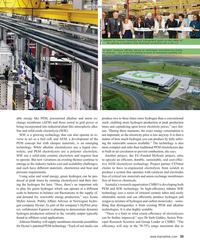 )
June 2024 - Maritime Reporter and Engineering News page: 35
)
June 2024 - Maritime Reporter and Engineering News page: 35GREEN HYDROGEN Accelera by Cummins leadership and distinguished guests cut the ribbon at the opening of Accelera’s ? rst electrolyzer production site in the U.S. In April, Fortescue of? cially opened an electrolyzer manufacturing facility in Australia – one of the ? rst globally to house an automated
-
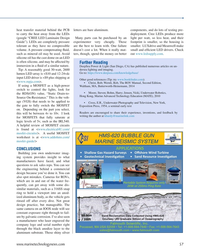 )
September 2023 - Marine Technology Reporter page: 57
)
September 2023 - Marine Technology Reporter page: 57heat transfer material behind the PCB letters are bare aluminum. components, and do lots of testing pre- to carry the heat away from the LEDs deployment. Cree LEDs produce more (google “CREE LED Luminaire Design Many parts can be purchased by an light per watt, so less heat, and their Guide”). LEDs
-
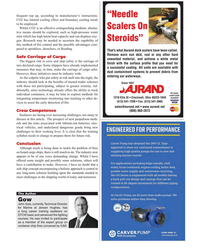 )
November 2022 - Maritime Reporter and Engineering News page: 33
)
November 2022 - Maritime Reporter and Engineering News page: 33frequent top up, according to manufacturer’s instructions. “Needle CO2 has limited cooling effect and boundary cooling needs to be employed. Whilst CO2 is an effective extinguishing medium, alterna- Scalers On tive means should be explored, such as high-pressure water mist which has high latent heat
-
 )
November 2022 - Maritime Reporter and Engineering News page: 30
)
November 2022 - Maritime Reporter and Engineering News page: 30FEATURE FIREFIGHTING Copyright kulkann/AdobeStock FIREFIGHTING AT SEA – TOWARDS A SAFE SHIP CONCEPT By John Gow, Technical Director Marine and Senior Investigator at Jensen Hughes Forensics he most important of all international maritime with emergency power, lighting and ? re protection. Regula- safety
-
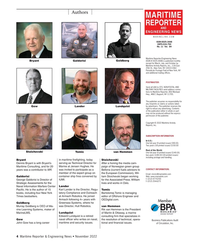 )
November 2022 - Maritime Reporter and Engineering News page: 4
)
November 2022 - Maritime Reporter and Engineering News page: 4Authors MARITIME REPORTER AND ENGINEERING NEWS M A R I N E L I N K . C O M ISSN-0025-3448 USPS-016-750 No. 11 Vol. 84 Maritime Reporter/Engineering News Bryant Galdorisi Goldberg (ISSN # 0025-3448) is published monthly except for March, July, and October by Maritime Activity Reports, Inc., 118 East
-
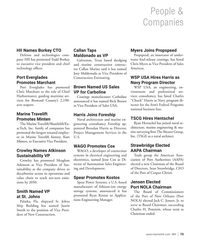 )
November 2022 - Marine News page: 73
)
November 2022 - Marine News page: 73People & Companies HII Names Borkey CTO Callan Taps Myers Joins Propspeed Defense and technologies com- Propspeed, an innovator of under- Maldonado as VP pany HII has promoted Todd Borkey Galveston, Texas based dredging water foul-release coatings, has hired to executive vice president and chief and
-
 )
November 2022 - Marine News page: 56
)
November 2022 - Marine News page: 56Feature Great Vessels of 2022 Dare County Owner: EJE Dredging Service Builder: Conrad Shipyard MISS KATIE Designer: Jensen Maritime Dredging Service, as part of a public/private part- and operation of a new split-hull dredge that could be used nership with Dare County, has recently taken mostly in maintaini
-
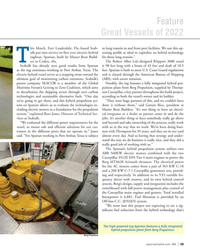 )
November 2022 - Marine News page: 49
)
November 2022 - Marine News page: 49Feature Great Vessels of 2022 his March, Fort Lauderdale, Fla.-based Seab- to long transits to and from port facilities. We saw this op- ulk put into service its ? rst ever electric-hybrid erating pro? le as ideal to capitalize on hybrid technology tugboat, Spartan, built by Master Boat Build- for those
-
 )
August 2022 - Maritime Reporter and Engineering News page: 26
)
August 2022 - Maritime Reporter and Engineering News page: 26BATTERIES hoping to produce 25 GWh a year in installable power and then from a 2-phase, 32 GWh giga-factory. Jensen said at a Pareto webinar in January that global battery demand would reach 5,300 GWh (mostly vehicles) by 2030, with some 670 GWh in ESS demand. Freyer targets 43 GWh of cell produc- tion
-
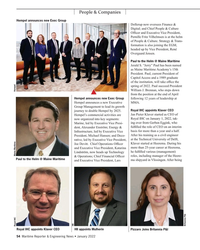 )
January 2022 - Maritime Reporter and Engineering News page: 54
)
January 2022 - Maritime Reporter and Engineering News page: 54Fritz Vilhelmsen is at the helm of People & Culture. Strategy & Trans- formation is also joining the EGM, headed up by Vice President, René Overgaard Jensen. Paul to the Helm @ Maine Maritime Jerald S. “Jerry” Paul has been named as Maine Maritime Academy’s 15th President. Paul, current President of
-
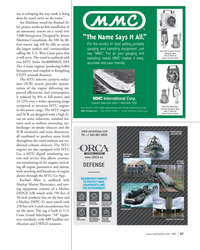 )
November 2021 - Marine News page: 57
)
November 2021 - Marine News page: 57my is reshaping the way work is being done by vessel crews on the water.” Sea Machines noted the Rachael Al- len project marks its ? rst installation of an autonomy system on a vessel over 5,000 horsepower. Designed by Jensen Maritime Consultants, the 100- by 40- foot tractor tug will be able to
-
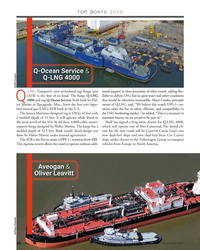 )
December 2020 - Marine News page: 32
)
December 2020 - Marine News page: 32TOP BOATS 2020 Q-Ocean Service & Q-LNG 4000 -LNG Transport’s new articulated tug barge unit tional support in close proximity of other vessels, adding ? ex- (ATB) is the ? rst of its kind. The barge Q-LNG ibility to deliver LNG fuel in open water and other conditions Q 4000 and tug Q-Ocean Service
-
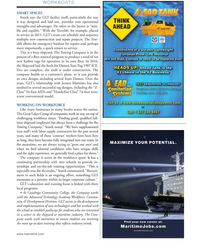 )
November 2020 - Marine News page: 41
)
November 2020 - Marine News page: 41WORKBOATS SMART SPACES Starck says the GLT facility itself, particularly the way it was designed and laid out, provides core operational strengths and advantages. He refers to the layout as “nim- ble and capable.” With the Travelift, for example, placed in service in 2011, GLT’s team can schedule and
-
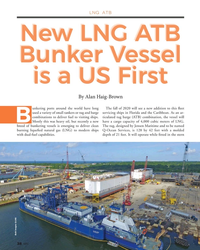 )
October 2020 - Marine News page: 38
)
October 2020 - Marine News page: 38VesselBunker VesselBunker Vessel Bunker Vessel is a US Firstis a US Firstis a US Firstis a US Firstis a US First By Alan Haig-Brown unkering ports around the world have long The fall of 2020 will see a new addition to this ? eet used a variety of small tankers or tug and barge servicing ships in Florida
-
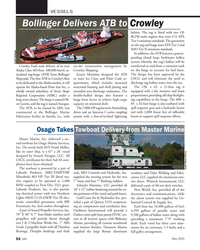 )
May 2020 - Marine News page: 52
)
May 2020 - Marine News page: 52VESSELS Bollinger Delivers ATB to Crowley helmet. The tug is ?tted with two GE 8L250 main engines that meet U.S. EPA Tier 4 emissions standards. The generators on the tug and barge meet EPA Tier 3 and IMO Tier II emissions standards. In addition, the ATB features a patent- pending closed loop, freshwater
-
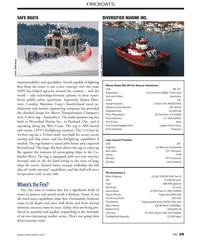 )
December 2019 - Marine News page: 49
)
December 2019 - Marine News page: 49FIREBOATS SAFE BOATS DIVERSIFIED MARINE INC. Credit: SAFE Boats Credit: Jensen Maritime maneuverability and operability. Vessels capable of ? ghting Moose Boats M2-38 Fire Rescue Catamaran ? res from the water is not a new concept; over the years LOA: 38’-10” SAFE has helped agencies around the
-
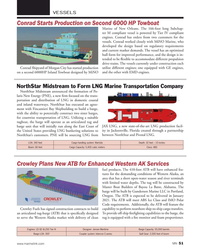 )
October 2019 - Marine News page: 51
)
October 2019 - Marine News page: 51VESSELS Conrad Starts Production on Second 6000 HP Towboat Marine of New Orleans. The 166-foot long Subchap- ter M compliant vessel is powered by Tier IV compliant engines. Conrad has orders from two customers for the vessels. Conrad worked closely with MiNO Marine, who developed the design based on
-
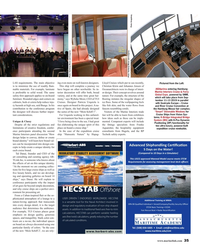 )
July 2019 - Maritime Reporter and Engineering News page: 35
)
July 2019 - Maritime Reporter and Engineering News page: 35Photo: Kongsberg Photo: Hamburg Messe and Congress Photo: Hamburg Messe and Congress LAS requirements. The main objective ing even more on well-known designers. Lloyd Cruises which put to sea recently, Pictured from the Left: is to minimize the use of readily ? am- This ship will complete a journey we
-
 )
May 2019 - Maritime Reporter and Engineering News page: 57
)
May 2019 - Maritime Reporter and Engineering News page: 57WORKBOATS: INSIDE THE U.S. WORKBOAT MARKET with Caterpillar engines. Two 6,700 hp tractor tugs Monitoring the Energy Markets America’s Marine Highway grants, announced in April have already been delivered and are now stationed in Developments in the energy markets are set to impact 2019, included $3.
-
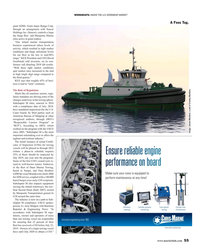 )
May 2019 - Maritime Reporter and Engineering News page: 55
)
May 2019 - Maritime Reporter and Engineering News page: 55WORKBOATS: INSIDE THE U.S. WORKBOAT MARKET A Foss Tug. giant ADM). Grain major Bunge Corp, through an arrangement with Seacor Holdings Inc. (Seacor), controls a large dry barge ? eet and Marquette Marine (also active in grain trades). “Our inland marine transportation business experienced robust
-
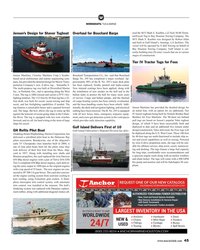 )
February 2019 - Maritime Reporter and Engineering News page: 45
)
February 2019 - Maritime Reporter and Engineering News page: 45W WORKBOATS: TUG & BARGE ered the M/V Mark E. Kuebler, a Z-Tech 30-80 Termi- Jensen’s Design for Shaver Tugboat Overhaul for Bouchard Barge nal/Escort Tug to Bay Houston Towing Company. The M/V Mark E. Kuebler was designed by Robert Allan and built at Gulf Island’s, Jennings, LA facilities. The vessel
-
 )
February 2019 - Marine News page: 51
)
February 2019 - Marine News page: 51VESSELS Crowley’s LNG-Fueled ConRo Taíno Completes Maiden Voyage (LNG) – completed its maiden voyage to Puerto Rico on Friday morning, January 11th. The successful transit begins a new era of world-class supply chain services between the island commonwealth, U.S. mainland and the Caribbean Basin. Taíno
-
 )
February 2019 - Marine News page: 50
)
February 2019 - Marine News page: 50VESSELS Jensen’s Design for Shaver Transportation’s New Tugboat purpose tug was built at Diversifed Marine Inc., in Port- land, Ore., and is operating along the West Coast. The tug is ABS-classed and carries a FFV1 frefghting notation. The 112-foot by 44-foot tug has a 22-foot draft, was built for escort
-
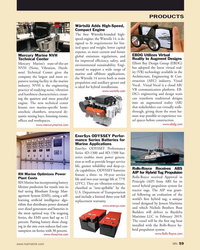 )
January 2019 - Marine News page: 59
)
January 2019 - Marine News page: 59PRODUCTS Wärtsilä Adds High-Speed, Compact Engine The ? rst Wärtsilä-branded high- speed engine; the Wärtsilä 14, is de- signed to ? t requirements for lim- ited space and weight, lower capital expense, to meet current and future Mercury Marine NVH EBDG Utilizes Virtual global emissions regulations
